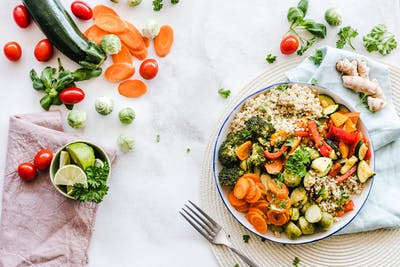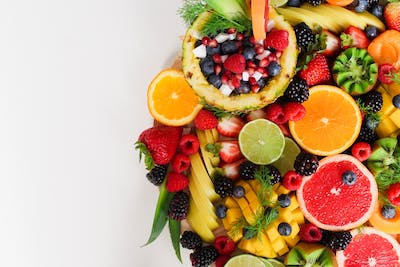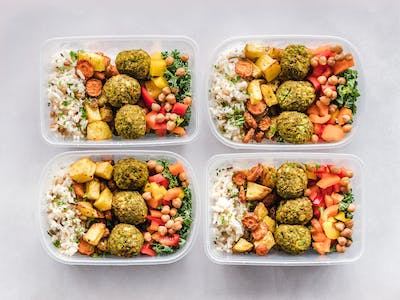The term ‘meal prep’ gets thrown around a lot by fitness enthusiasts and there are now countless businesses offering this as a support for weight loss and other nutrition or fitness goals. It simply means pre-preparing meals and storing them until you’re ready to eat them, often preparing several meals at a time in advance. Whilst the term may conjure up images of repetitive and bland chicken and rice in a tiny little Tupperware tub – it doesn’t have to be like that! Meal prep isn’t just for those on restrictive regimes and can be a huge help for any fitness and nutrition goals or just those of us living everyday busy lives that would like to make some healthy changes. This blog covers some of the benefits as well as some top tips if you want to give it a go yourself!
Benefits of meal prep:
It saves time – By cooking and preparing enough for several meals at once, you’re saving the time spent chopping, cooking and washing up after every single meal. It’s the perfect time-economical way to cook and eat and avoids us having to prepare food on the most jam-packed days.
Better nutrition – When we plan our meals in advance, we’re much more likely to make better nutritional choices as opposed to when hungry. When we’re tired or in a rush we crave high energy, quick-fix foods such as sugary and fatty options. By pre-planning we can ensure a balanced meal with a good mix of macro and micronutrients and make sure we include some towards our 5-a-day fruit and veg.

Portion control – When we meal prep, we calculate in advance how many meals we want our batch of ingredients to cover. Plating meals up or putting them into reusable containers helps to ensure that we stick to more reasonable portion sizes as opposed to piling up our plates and not stopping until it’s clean, often ignoring or not being aware of our bodies hunger/fullness cues (we all do it, right?!)
It saves money – One way it does this is that we often pay much less when buying products in bulk such as meat/ vegetables/ larger packs of eggs etc. If we’re preparing larger amounts of food we can make better use of bulk buy deals such as buy one get one half price. We can cook the ingredients as fresh as possible and freeze or refrigerate meals or excess. This also reduces food waste which is wasted money for us as buyers. Another way meal prep saves us money is that we’re much less likely to buy food on the go/ order takeaways, which are often extremely expensive compared to home cooking purely for the convenience.
Top tips when meal-prepping:
Get organised- Plan what meals you want to make in advance and write your shopping list. Shop as close to preparing your meals as possible for maximum freshness and freeze or refrigerate meals as needed.

Balance your plate – Try to include a source of protein, complex carbohydrates and some fruit or vegetables at every meal. Take time to get familiar with approximate portion sizes of each of these food groups to ensure your meals give you great all-round nutrition.
File your favourites – Keep your favourite go-to recipes for future reference and to make meal planning and prepping even easier in future.
Mix it up – Aim for a variety of protein and carbohydrate sources in your meals and experiment with different colours of fruit and vegetables. This will help to ensure maximum nutritional value as well as keeping your meals interesting! See below for ideas.
Set time aside – This could be a regular day/morning/afternoon each week but by protecting that time you can be sure your diet will be one less thing to worry about for the following days.
Choose things that keep well – You can always add vegetables/ salad/ sauces at the time of eating to keep things fresher

Additional ideas:
For breakfasts try – Overnight oats/Weetabix, bircher muesli, fruit and yoghurt,
ready made egg muffins, home-made oat-based/sugar free breakfast biscuits or bars.
Many of these also work well as snacks throughout the day.
Other snacks could include – hard boiled eggs, chopped fruits/vegetables with dips such as houmous or reduced sugar chocolate or toffee sauce.
Meal ingredient ideas include:
Proteins – Low fat dairy such as cottage cheese or cheese, beef chunks or minced meat, sausages or pulled pork, chicken or turkey fillets or chunks, salmon or white fish, tinned tuna/mackerel/sardines, beans/chickpeas, eggs
Carbohydrates – Pasta shapes or spaghetti, rice, quinoa, cous cous or other mixed grains, potatoes, sweet potatoes (roast, boiled or mashed), pitta breads or rice cakes/crackers, oats
Add sauces and spices to your taste and try to stick to lower-fat/sugar/salt options for an extra health boost where possible.
Fruits and veggies to include: Berries, bananas, chopped apples/pears, dried fruits such as raisins and apricots
Broccoli, asparagus, green beans, carrots, mixed salad ingredients such as peppers/cucumber/celery/leaves. Try a variety of methods of eating/cooking such as raw, boiled or steamed or stir fried to improve taste and variety.
Written by Bev Meadows – Personal Trainer/ Exercise Referral Officer and Complementary Therapist
Instagram @bevs_life

